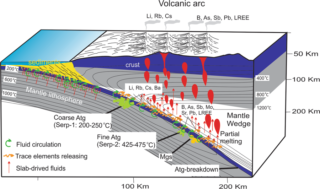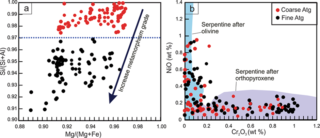Origin of arc magmatic signatures
A temperature dependent process for trace element (re)-mobilization in subduction zones
Serpentinites are a major potential carrier of water (up to 15 %) and incompatible fluid-mobile elements (FME) into the subduction zone. They can be stable to high temperatures (620oC) and pressures (5 GPa) at depths of up to 150–200 km, and their hydration (and subsequent dehydration) critically influence the generation and chemistry of arc-related magmas. Numerous previous studies have been carried out on serpentinites with the aim of defining the behavior of fluid-mobile elements and rare earth elements (REE) during subduction. These studies highlighted the role of the original minerals (i.e., olivine vs. pyroxene) and temperature on trace element distributions during the subduction process.
The work recently published in Scientific Reports uses the results of a detailed petrological, mineralogical and geochemical study from selected Neoproterozoic serpentinite bodies in the Arabian-Nubian Shield to constrain the role of temperature within the stability field of antigorite on the distribution of FME and REE in subduction zones. It also argues against this prevailing view and instead provides evidence for the systematic distribution of FME and REE in subduction zones that depends on temperature conditions of the subducting slab. It also illustrates how the resultant cross-arc geochemical trends may help to determine the subduction polarity of ancient arcs in Earth’s history.


Contact person: Zheng-Xiang Li, Earth Dynamics Research Group, Curtin University.
Relevant publication:
Hamed Gamal El Dien, Zheng-Xiang Li, Yongwoo Kil, Tamer Abu-Alam, Origin of arc magmatic signature: A temperature dependent process for trace element (re)-mobilization in subduction zones. Scientific Reports, Volume 9, Article 7098 (2019).; doi.org/10.1038/s41598-019-43605-9.
